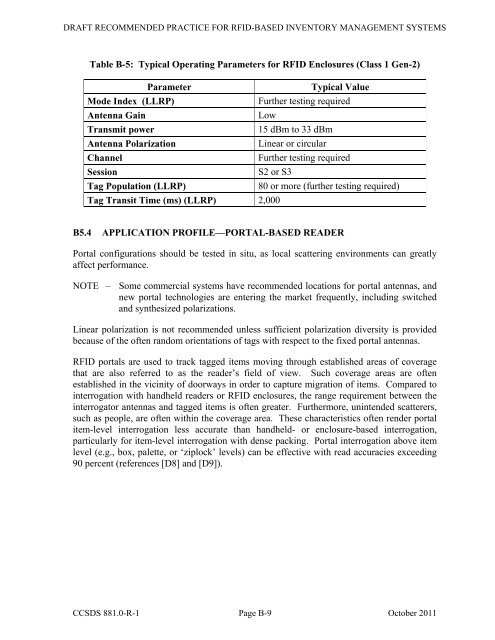CCSDS 881.0-R-1, Spacecraft Onboard Interface ServicesâRFID ...
CCSDS 881.0-R-1, Spacecraft Onboard Interface ServicesâRFID ...
CCSDS 881.0-R-1, Spacecraft Onboard Interface ServicesâRFID ...
Create successful ePaper yourself
Turn your PDF publications into a flip-book with our unique Google optimized e-Paper software.
DRAFT RECOMMENDED PRACTICE FOR RFID-BASED INVENTORY MANAGEMENT SYSTEMSTable B-5: Typical Operating Parameters for RFID Enclosures (Class 1 Gen-2)ParameterTypical ValueMode Index (LLRP)Further testing requiredAntenna GainLowTransmit power15 dBm to 33 dBmAntenna PolarizationLinear or circularChannelFurther testing requiredSessionS2 or S3Tag Population (LLRP)80 or more (further testing required)Tag Transit Time (ms) (LLRP) 2,000B5.4 APPLICATION PROFILE—PORTAL-BASED READERPortal configurations should be tested in situ, as local scattering environments can greatlyaffect performance.NOTE – Some commercial systems have recommended locations for portal antennas, andnew portal technologies are entering the market frequently, including switchedand synthesized polarizations.Linear polarization is not recommended unless sufficient polarization diversity is providedbecause of the often random orientations of tags with respect to the fixed portal antennas.RFID portals are used to track tagged items moving through established areas of coveragethat are also referred to as the reader’s field of view. Such coverage areas are oftenestablished in the vicinity of doorways in order to capture migration of items. Compared tointerrogation with handheld readers or RFID enclosures, the range requirement between theinterrogator antennas and tagged items is often greater. Furthermore, unintended scatterers,such as people, are often within the coverage area. These characteristics often render portalitem-level interrogation less accurate than handheld- or enclosure-based interrogation,particularly for item-level interrogation with dense packing. Portal interrogation above itemlevel (e.g., box, palette, or ‘ziplock’ levels) can be effective with read accuracies exceeding90 percent (references [D8] and [D9]).<strong>CCSDS</strong> <strong>881.0</strong>-R-1 Page B-9 October 2011

















